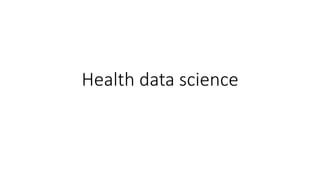
Predicting Health Outcomes from Data
- 2. Why study data science?
- 3. Why study data science?
- 4. What is health data science? • Data-driven solution to solve complex real world health problems • Or to derive knowledge from unstructured and messy data • It is an interdisciplinary field: biostatistics, computer science, epidemiology, public health, mathematics, etc
- 6. Real life health data science example • HIV: • Visualising the pattern of early HIV transmission within the mucosal barrier • COVID-19: • What can predict covid-19 neutralisation activity? • Can we predict covid-19 vaccine efficacy?
- 8. Background • Early HIV transmission event might occur during vaginal or anal sex • Want to investigate if the mucosal barrier (within the vaginal tissue) is effective in blocking HIV virus transmission or not
- 9. If the mucosal barrier is good in preventing viral transmission, this is what we expect to see
- 10. If the mucosal barrier is not good at preventing transmission, multiple viruses can be found (random infection)
- 11. If the mucosal barrier is not good at preventing transmission, multiple viruses can be found (clustered infection)
- 13. Data
- 14. 14 Data Visualisation Can still see many viral variants no evidence that the vaginal tissue is effective in blocking viral entry
- 15. Need a formal method • How can we say (formally) if infection is spatially clustered (or not) ? • Mantel test (or Mantel and Valand) -> relate a matrix of “geographical” distance and a matrix of “biological” distance • So, need to define the “geographical” matrix and “biological” matrix first 15
- 16. “Geographical” distance • Euclidean distance di, j = (xi - xj )2 +(yi - yj )2 16
- 17. “Biological” distance • Morisita – Horn index of overlap MH = 2 n1in2i N1N2 i å n1i 2 N1 + n2i 2 N2 i å 17
- 18. “Biological” distance • Similarity between 1 and 2 = 0.98 • Similarity between 1 and 3 = 0.46 18
- 19. Mantel Test (or Mantel and Valand) • Testing the association between two matrices • Mantel quantity (Zm) is given by: • Basic idea -> permutation test • Randomly changing the rows and columns of the two matrices • And store the value of Zm for each permutation of rows and columns Zm = gij j å i å bij 19
- 20. 20 Low p-values: infection is clustered locally within the vaginal tissue
- 21. What can predict covid-19 viral neutralisation activity?
- 22. Background • Neutralising antibody (NAb): antibody that can defend the host from the specific pathogen • Data: 41 convalescent adults; measured several immunological parameters (13 parameters total) • Goal: want to know in those 41 recovered patients, what immunological parameters can be used to predict NAb
- 23. Methods • Data visualisation is very important in data science • First step: plot the correlation matrix for the whole dataset
- 24. Microneutralization is positively correlated with SARS-CoV-2 RBD Microneutralization is negatively correlated with CCR6+CXCR3-
- 25. Ok, not very informative…. Have so many things correlated with microneutralization
- 26. Methods • Correlation matrix shows that Nab is correlated with so many things • Next step: Can I find some hidden features in this dataset? • Method: principal component analysis (PCA)
- 27. The main focus is microneutralization If the angle between microneut and another variable is less than 90o; then it’s a positive association If the angle between microneut and another variable is greater than 90o; then it’s a negative association
- 28. For instance, higher ELISA S trimer gives higher microneutralization level (less than 90o) For instance, higher CCR6+CXCR3- gives lower microneutralization level (more than 90o)
- 29. Methods • PCA visualisation is better than correlation matrix • But, still cannot just pick one thing that can be used to predict NAb • Next step: I want to only pick one thing to predict NAb • Method: multiple linear regression with a backward model selection strategy • The idea is to run a linear regression with all the variables, and iteratively remove non-significant predictor until all the predictors are significant
- 30. Two main things are highly predictive of NAb
- 32. Background
- 33. Background • At the end of the phase 2 trial, we get the immunogenicity data (measuring the amount of antibody) • Given the data from phase 2 trial (antibody data), can we predict what the efficacy of the vaccine will be? • Training dataset: efficacy and antibody data from all available vaccines
- 34. Methods • The first step is always to visualise your data, so why don’t we plot efficacy against antibody first?
- 35. High antibody = high efficacy Low antibody = low efficacy Can we simply do a classification method based on the level of antibody?
- 36. Methods • The model is a distribution-free binary classification model, based on the threshold level of antibody • The lower your antibody level, higher chance for you to be infected, so the vaccine efficacy will be lower • The higher your antibody level, lower chance for you to be infected, so the vaccine efficacy will be higher • We want to know what is this threshold of antibody
- 37. We normalised the antibody to the convalescent patients (the mean for convalescent is one) Covaxin data came out a bit later, so we used covaxin to validate our ‘classifier’ model Using our classifier, as long as we have antibody data (from phase 2 trial), we can predict any vaccine efficacy
- 38. CureVac mRNA vaccine failure – why???
- 39. Simple data visualisation can help to answer Because lower dose than Pfizer and Moderna